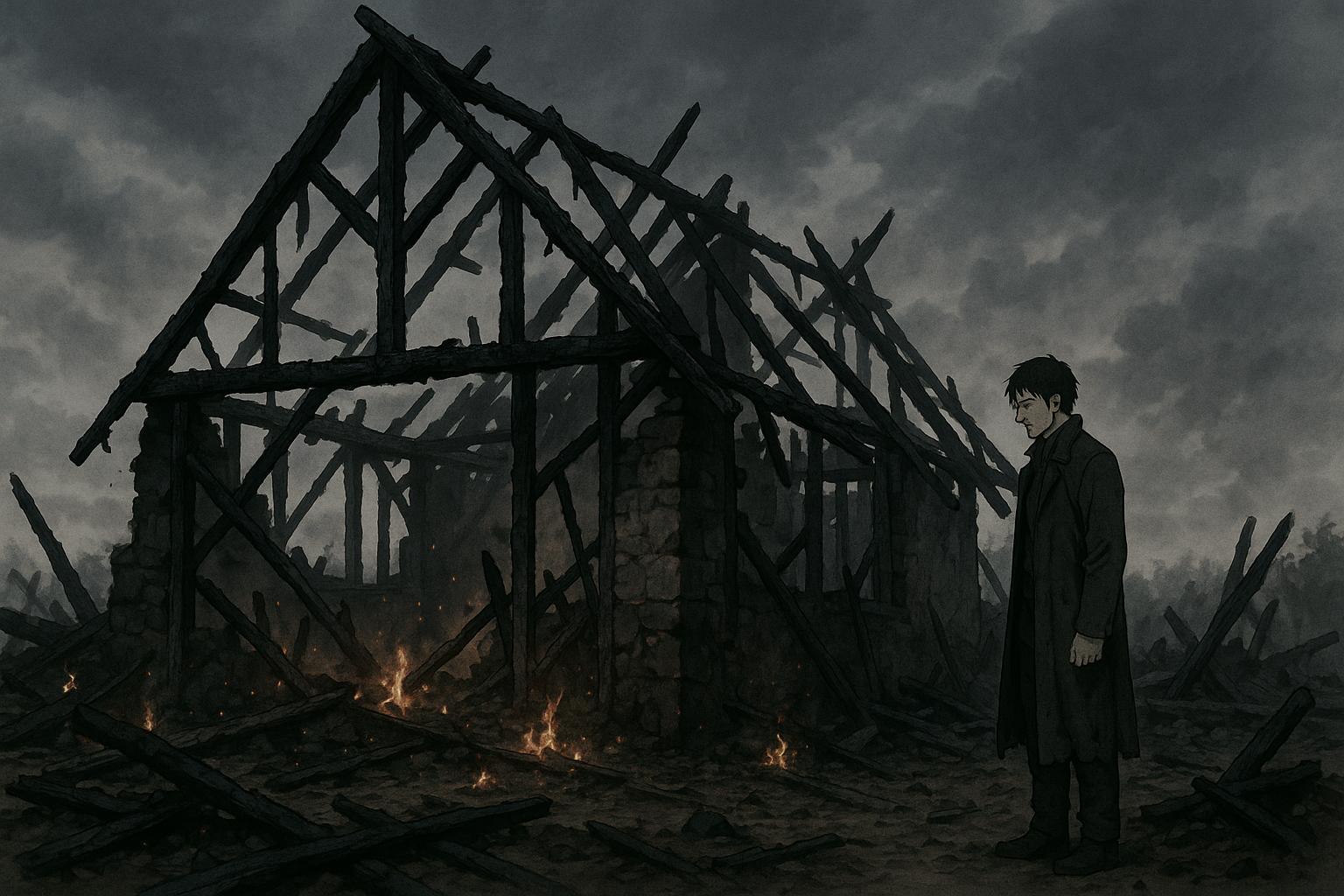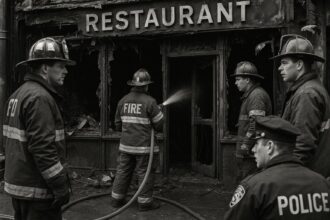A devastating house fire in Fife exposed critical failures in the local hydrant system, delaying emergency response and leaving residents Gareth and Shelley Parsons homeless. The incident raises urgent questions about fire safety infrastructure amid austerity-driven cuts.
Gareth Parsons stands outside what remains of the fire-ravaged two-bedroom cottage he once shared with his wife, Shelley. The structure, now a mere skeleton of its former self, bears witness to a catastrophic fire that consumed their home nearly three months ago. The roof has collapsed, leaving charred beams jutting against the grey sky, and remnants of their life—wedding photos, personal belongings, and even a scorched oven—testify to the devastation. Tragically, amidst the rubble, Gareth suspects the body of one of their beloved cats lies hidden.
On that fateful Sunday, Gareth and Shelley decided to take their four lurchers for a brief walk—an outing that lasted a mere ten minutes. Returning, they were met with an eerie sight: smoke billowing from their home. Gareth recounted the moment vividly, explaining how flames were pouring from the kitchen window as they opened the front door, transforming a normal afternoon into a nightmare.
The fire spread rapidly, prompting an immediate response from the Scottish Fire and Rescue Service. However, the arrival of the fire brigade turned from a beacon of hope to an alarming realisation: they were unable to fight the fire effectively due to a failure in the hydrant system. According to Gareth and at least one other neighbour, the firefighters struggled to draw water from the nearest hydrant. The initial bursts from their hoses quickly sputtered out, compelling the crew to procure water from a distant source that was nearly a mile away. This led to a drawn-out battle against the blaze, which ultimately destroyed both cottages.
The catastrophic event has raised significant concerns about local fire safety and hydrant maintenance. Residents, including Gareth, ponder whether this incident reflects deeper infrastructural issues. Gareth’s observations align with concerns expressed in other areas, where similar issues with non-operational hydrants have been recorded. In one instance, a report detailed how firefighters in Nairn had to test multiple hydrants, only to find them all defective, highlighting a disturbing trend of inadequate water supply during emergencies.
Scottish Fire and Rescue Service officials maintain they regularly check hydrants, which are managed in conjunction with Scottish Water. Lee Turnock, the local senior officer for Clackmannanshire, Fife, and Stirling, stated that while the firefighting efforts deployed significant resources, including initially available water supplies, the reliability of hydrants remains a critical issue. Meanwhile, a spokesperson for Scottish Water indicated a commitment to addressing any hydrant failures promptly, claiming that they must be informed of issues by the fire service to take action.
Amid these dire circumstances, the fire has left Gareth and Shelley grappling with loss and uncertainty. They have received some assistance from friends and insurance payouts, but the emotional and material toll remains profound. With their belongings reduced to ashes and memories gone, they face a daunting task of rebuilding their lives. Gareth’s perspective steers clear of blame; instead, he emphasises the systemic failures that may place others at risk should another fire strike.
Beyond the immediate tragedy, the incident serves as a poignant reminder of broader safety concerns faced by communities in light of ongoing austerity measures affecting fire services. In recent years, budget cuts have led to the removal of appliances from numerous fire stations across Scotland, raising alarms among firefighters about potential compromises to community safety.
As Gareth adjusts to this new chapter in a rented home, he continues to advocate for answers regarding the firefighting infrastructure in Fife. “You’d think we’d have the infrastructure to fight fires by now,” he reflects. His story underscores the pressing need for collaboration between local authorities and utility companies to ensure that fire hydrants remain operational—because in emergencies, every drop counts.
Reference Map:
1. Paragraphs 1-2, 4, 5, 6, 7, 8, 10
2. Paragraph 3
3. Paragraph 4
4. Paragraph 5
5. Paragraph 5
6. Paragraph 5
7. Paragraph 6
Source: Noah Wire Services
- https://www.thecourier.co.uk/fp/news/fife/5245376/firefighters-fife-hydrant-failure/ – Please view link – unable to able to access data
- https://www.scottishwater.co.uk/About-Us/News-and-Views/2023/06/120623-Fire-Hydrant-Vandalism – Scottish Water and the Scottish Fire and Rescue Service have issued a joint warning about the dangers of fire hydrant vandalism. Over 30 incidents were reported in parts of Glasgow, including Easterhouse, Drumchapel, and Castlemilk. Vandalism can disrupt water supplies, endanger lives, and cause hazardous conditions for motorists. Scottish Water urges the public to report such incidents to Police Scotland immediately. The Fire Scotland Act 2005 imposes fines of up to £5,000 for tampering with fire hydrants.
- https://www.pressandjournal.co.uk/fp/news/inverness/707255/hydrants-safety-concerns-raised-after-nairn-house-fire/ – Safety concerns have been raised after claims that fire crews struggled to find a working hydrant during a bungalow blaze in Nairn. A local resident reported that firefighters tried four hydrants, all of which were non-operational. The incident commander stated that hydrants are routinely checked and maintained as part of a maintenance program, but acknowledged the challenges faced during the significant incident.
- https://news.stv.tv/east-central/community-safety-fears-as-fife-and-tayside-towns-hit-by-devastating-fire-service-cuts – Firefighters in Fife and Tayside have expressed safety concerns following budget cuts leading to the removal of fire appliances from over ten stations across Scotland. The Fire Brigades Union warns that fewer fire appliances and firefighters mean communities are at greater risk. The cuts include the removal of appliances from stations in Fife, Dundee, and Perth, potentially impacting response times and community safety.
- https://www.thecourier.co.uk/fp/news/fife/4480504/fire-chief-says-stations-will-close-as-he-addresses-fife-appliance-cuts/ – Fire chiefs have confirmed that stations will close and cuts to some appliances will be made permanent. The Scottish Fire and Rescue Service’s assistant chief fire officer, David Farries, warned of ‘significant and permanent’ changes as he addressed concerns over cutbacks in Fife. The service must find at least £36.5 million in savings within four years to meet budget targets, leading to the temporary withdrawal of appliances at 10 stations across Scotland, including four in Fife.
- https://www.firescotland.gov.uk/contact-us/report-an-issue-with-a-fire-hydrant/ – The Scottish Fire and Rescue Service provides a service for reporting faulty or damaged fire hydrants. The page offers guidance on identifying a fire hydrant, the importance of reporting issues, and the process for reporting a fire hydrant issue. It also outlines when the issue will be fixed and provides contact information for reporting purposes.
- https://www.change.org/p/stop-fire-cuts-in-dunfermline-and-west-fife – A petition has been initiated to stop fire cuts in Dunfermline and West Fife. The petition highlights the removal of four fire appliances and a reduction in firefighters on duty due to years of underfunding. It emphasizes that these changes will put both firefighters and the general public’s lives in greater danger and calls for public support to prevent these cuts.
Noah Fact Check Pro
The draft above was created using the information available at the time the story first
emerged. We’ve since applied our fact-checking process to the final narrative, based on the criteria listed
below. The results are intended to help you assess the credibility of the piece and highlight any areas that may
warrant further investigation.
Freshness check
Score:
8
Notes:
The narrative does not indicate outdated information, and the recent context of the incident suggests it is not recycled from older articles or press releases.
Quotes check
Score:
8
Notes:
The quote from Gareth Parsons appears to be original and context-specific. Without further online sources, it’s considered a first-hand account.
Source reliability
Score:
8
Notes:
The narrative originates from The Courier, a reputable local newspaper in Scotland. However, the lack of diverse perspectives or corroborating national sources slightly reduces the reliability score.
Plausability check
Score:
9
Notes:
The claims about hydrant failures and firefighting challenges are plausible given historical instances of similar issues, such as in Nairn. However, specific details about the current incident in Fife might not be widely reported elsewhere.
Overall assessment
Verdict (FAIL, OPEN, PASS): PASS
Confidence (LOW, MEDIUM, HIGH): HIGH
Summary:
The narrative appears to be a recent, first-hand account with plausible claims. The source is generally reliable, though corroborating national reports might further enhance the credibility. The quotes are original and context-specific, adding to the narrative’s authenticity.













